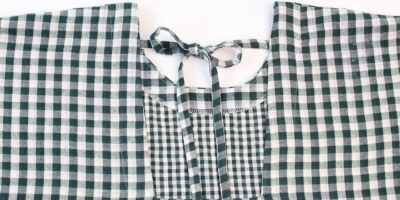If you are looking for help fitting your Shay dress pattern, you’ve found the right post! We have put together this post covering the most common fitting adjustments for the Shay. Find fitting posts for each of our patterns in the fitting and custom adjustments library here.
Please check out our Shay Tester Inspiration post here if you’re interested in seeing it on a variety of body types. During testing, we work through the fit for each tester, which helps inform what fitting and custom adjustments we talk about in our fitting posts. Most of these adjustments are included in the pattern tutorials, and if more fit questions come up, we will continue to add them to the blog post.
The Shay pattern is a maxi dress with a wide scoop neck and fitted bodice. The skirt has three gathered tiers. There are elbow length puff sleeves and a tank option for both views. View A finishes with a center back invisible zipper. View B finishes with center front buttons.
Before we get started, I always like to add a note that the goal should be to create a comfortable garment that you will enjoy wearing. I don’t think it’s important to get rid of every single drag line and pull, so be kind to yourself as you are analyzing your fit. If you have specific questions about fitting the Shay pattern, you can always reach out in our Chalk and Notch Facebook Group or email us here.
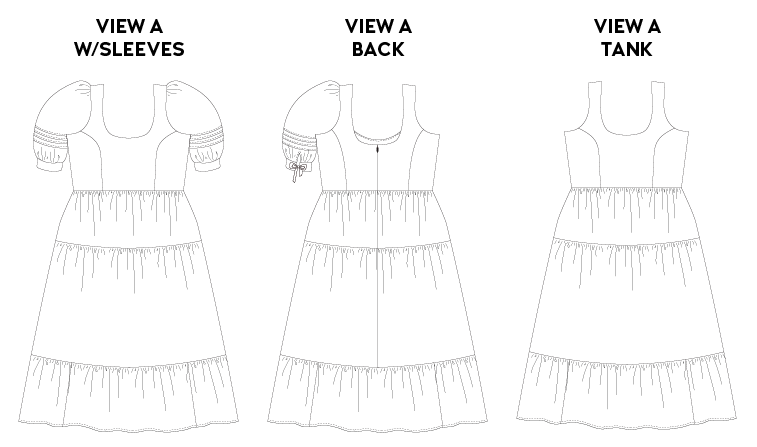
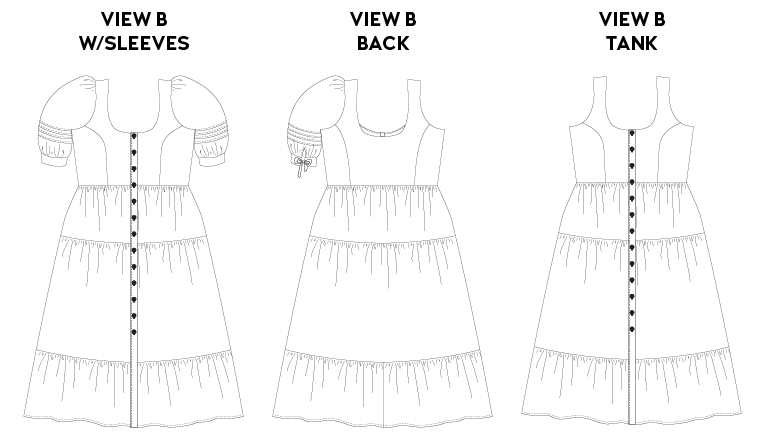
HOW TO PICK A SIZE
First, make sure you take new measurements before starting any project because our bodies change, and starting with accurate numbers is the first step to getting a good fit. You will need the following measurements:
High Bust – Around your body, just under the arms. Keep your arms relaxed by your side.
Full Bust – The fullest part of your bust.
Waist – Measure high above the navel. This is the intended finished waist placement.
Hips – Measure the widest point. But due to the amount of ease, this measurement is less important when picking a size.
BODY MEASUREMENTS
Use the high bust to determine your dress size, and use the difference between your high bust and full bust to choose your cup size. If you are between sizes, size up and fit the pattern as needed. It is always recommended to sew a test garment to confirm fit. This pattern requires a bodice fitting to confirm fit.
This pattern includes four bust cup options, and the cup size is determined by calculating the difference between the high and full bust. If the difference between your high bust and full bust is 1” (2.5 cm) use the A cup. If the difference between your high bust and full bust is 2” (5 cm) use the B cup. If the difference between your high bust and full bust is 3” (7.5 cm) use the C cup. If the difference between your high bust and full bust is 4” (10 cm) use the D cup. If you have more than a 4” (10 cm) difference, you may need a full bust adjustment. More details are in the custom fitting section below.
FINISHED GARMENT MEASUREMENTS
This style is designed to have a fitted bodice and full tiered skirt. There is 1” (2.5 cm) of ease through the bust. There is 2” (5 cm) of ease through the waist. There is 13” (33 cm) of ease through the hips.
The bodice length finishes at or right above the natural waist. The finished length of the dress ends above the ankle. Review the finished garment measurements to determine if you would like to adjust the length.
REVIEW THE INTENDED EASE
FULL BUST
The Shay includes 1” (2.5 cm) of ease through the full bust. This does not allow for much error in sizing. If you are between sizes, you can size up as you test the bodice. It’s always easier to take in. You may also want less ease if sewing the center back zipper and want a snug fit. You will want at least 1” (2.5 cm) of ease through the full bust if sewing the button front so that there is no pulling at the button placket.
WAIST
The Shay includes 2” (5 cm) of ease through the waist. You may want less ease if sewing the center back zipper or you like a more defined waistline. If you find that your waist changes more than 2” (5 cm) when sitting, you may want more ease.
HIPS
The Shay includes 13” (33 cm) of ease through the hips. Due to the full-tiered skirt, your hips can fall into different sizes and the dress will still look as designed.
SKIRT LENGTH
The finished length of the dress ends above the ankle, but it can be made shorter or longer based on your height or your length preference. Check the finished garment measurement to confirm the length from the waist to the hem measurement.
MAKING A TEST BODICE
I will always advise you to make a muslin or toile (test garment) before cutting into your final fashion fabric. This pattern requires a bodice fitting to confirm fit. As a reminder, the fabric will affect fit, and we have a recommended fabric post for the Shay pattern here.
TIPS FOR SEWING A TEST BODICE
- Sew a bodice to confirm the fit. If you add a lining, you will see the finished edge of the neckline and armhole. If not, mark the 3/8″ (1 cm) seam allowance to confirm the neckline and armhole depth/shape.
- When fitting the bodice, wear the undergarments you intend to wear with the dress.
- View A: pin the center back closed at 3/8” (1 cm) or add the center back zipper to confirm the fit.
- View B: add the center front placket to confirm the fit.
- Check the length from the shoulder to the armhole.
- Check the finished waist placement. Remember the skirt weight will pull the bodice lower.
- Check the bust shape. The princess seam should be to the outside of your bust point.
- Check your side seam and shoulder seam placement.
- Transfer any adjustments to your pattern.
CUSTOM ADJUSTMENTS
Often there are many ways to make the same adjustments. The following are the most common adjustments we have seen during testing.
ADJUSTING THE BODICE LENGTH – ARMHOLE
If you need to lengthen or shorten the armhole, you can make your pattern adjustment a few different ways.
Option 1 – Pattern Adjustment on the Straps
- Cut a horizontal line below the notch.
- Cut the front bodice and back bodice horizontally as indicated.
- If lengthening, add paper and add the amount desired.
- If shortening, overlap at the cut line the amount desired.
- Re-draw the armhole and neckline seams.
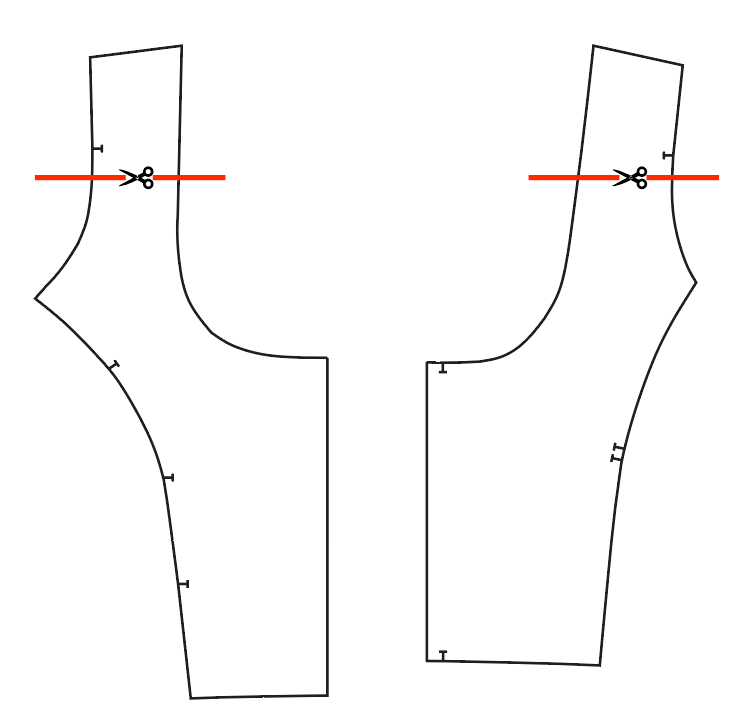
Option 2 – Adjusting at the Shoulder Seam. This is very similar to option 1 but might be more intuitive if you need to pin out the straps on your test bodice.
- Adjust the strap length at the top of the strap seam.
- If lengthening, add paper and add the amount desired.
- If shortening, trim the excess.
Option 3 – Adjusting the Lower Armhole. If the armhole feels too low or too high under the arm, you can adjust the side front and side back pieces.
- If lengthening, add paper and draw the new curve and height.
- If shortening, trim the excess and blend to zero at the princess seam.
- Make sure to keep a square corner at the armhole.
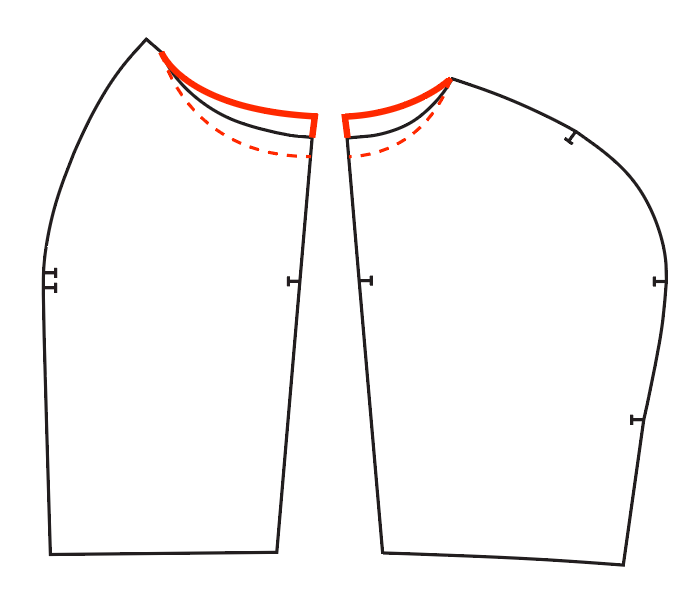
If you are sewing the sleeves and adjusting the straps, the sleeves notches will no longer match. If you shortened your straps and you don’t mind extra puff in your sleeve cap, you can gather the extra ease in the sleeve. If you lengthened your straps, you will have less gathers in your sleeve cap. Or you can cut a horizontal line in your sleeve cap and adjust your sleeve length to match the new armhole.
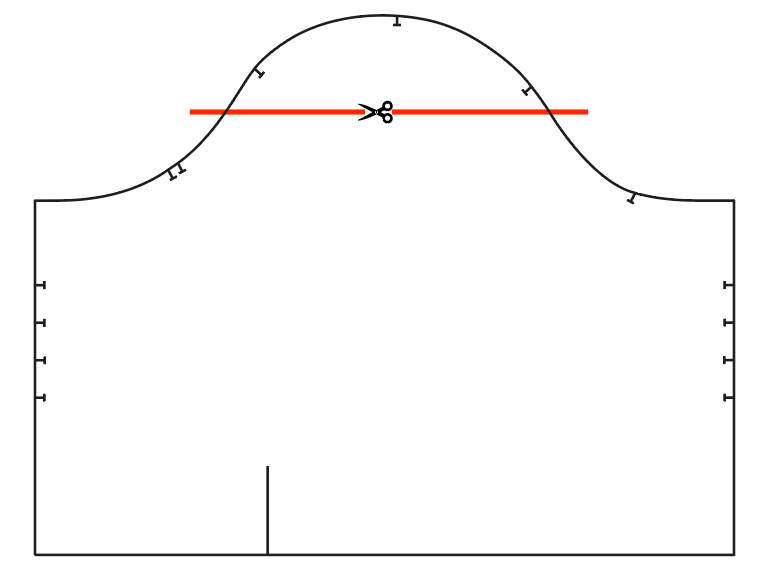
ADJUSTING THE SHOULDER SLOPE
When fitting your bodice, if your neckline is standing away at the shoulder, you may need to adjust your shoulder slope. Pinch out any gaping at the neckline at the shoulder point.
- Transfer the amount you pinched out on your flat pattern.
- Re-draw the shoulder slope angle.
ADJUSTING THE NECKLINE
The neckline is intended to be low but should still keep your bra covered. If you adjust your strap length, the neckline could have changed. You can reshape the front or back neckline based on your personal preference.
- Decide how much lower or higher you prefer the neckline.
- Re-draw the neckline scoop, keeping a 90-degree angle at the center front or center back corner. Then blend it back into the neckline.
- This will affect the center front placket length if sewing the button front view. Adjust as necessary.
ADJUSTING THE BODICE LENGTH – EVENLY AT THE WAISTLINE
The bodice is designed to hit at the natural waist or slightly above. If you need to lengthen or shorten the bodice the same amount all the way around, cut a horizontal line between the bottom edge and bottom notch.
- Cut the center front, side front, side back and center back bodice pieces as indicated.
- If lengthening, add paper and add the amount desired.
- If shortening, overlap at the cut line the amount desired.
- Re-draw the seams.
ADJUSTING THE BODICE LENGTH – JUST IN THE BACK
If you find that there is extra fabric at the back or back and side seams, you can shorten the bodice on a few pieces to make your bodice hem level. The easiest way to know how much to adjust is to fold up your test bodice hem so that it is level. Trace the amount that is folded and transfer that to your flat pattern. It could look something like this.
ADJUSTING THE WAIST EASE
It is recommended to choose a size based on your high bust measurement and cup size. If your waist falls into a different size, you can adjust your pattern at the waist at the princess seams and the side seams.
- First decide how much you want to adjust the waist. There are four princess seams and side seams that can all be adjusted.
- Decide where you want to add or remove the extra ease based on how much you need to adjust the sizing.
- If you need to adjust the waist 1” (2.5 cm) to 2” (5 cm), add 1/8” (0.3 cm) to 1/4” (0.6 cm) to each princess seam at the waist, blending back to the ribs near the first notch.
- If you need to adjust the waist 3” (7.5 cm), add 1/4” (0.6 cm) to each princess seam and to the side seams at the waist, blending back to the ribs near the first notch.
- You may find that you need more or less in different areas depending on your shape.
- Once you have confirmed your bodice, measure the finished waist. Use the skirt tiers that match the size of your finished waist. If you need to add to the size 30, the ratio included from the waist to tier 1 (and each additional tier) is 1:1.4.
ADJUSTING THE PRINCESS SEAM AT THE ARMHOLE
If you have gaping at the front or back armhole or just too much ease at the high bust, you can take in the top of the princess seam.
- Pinch out how much you want to remove and copy that to your bodice pieces.
- Double-check your sew lines and make sure the princess seams still sew to each other at a 1:1 ratio at the front and the back.
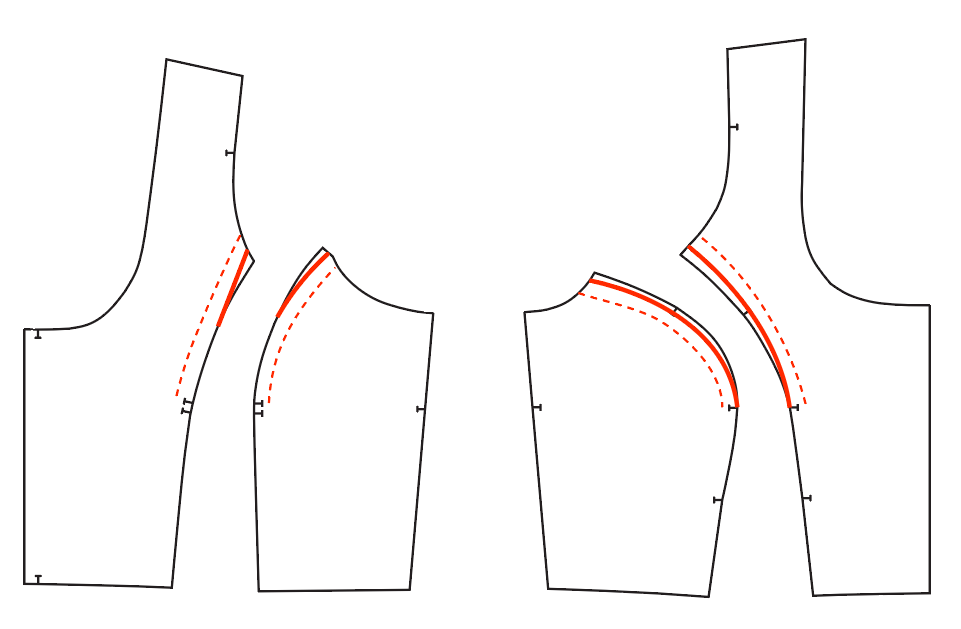
FULL BUST ADJUSTMENT
If you have over 4” (10 cm) between your high bust and full bust, you may need a Full Bust Adjustment to the D cup bodice. This is a quick method to add more fullness to the bust while leaving the high bust and waist measurements the same. You will still need to make a bodice muslin/test garment to confirm fit.
- First decide how much more ease you need through your bust. You will add half that amount to your pattern. If you need 1” (2.5 cm), then you will add 1/2” (1.25 cm) to the side bust pattern piece.
- Mark the seam allowance on the side front bust. Drop the bust point 1/4” (0.6 cm) for each 1/2” (1.25 cm) you are adding to the side bust pattern piece.
- Draw a new sew line 1/2” (1.25 cm) out from the new bust point. Blend the new cut line to zero at the top notch and before the bottom.
- Now you will need to add length back to the center front pattern piece. Measure the side bust between the top two notches. Cut the center front and add any necessary length.
- Repeat the process for the distance between the other notches.
- Once the seam length matches on both pattern pieces, you have completed the FBA.
- Make sure to add any additional length to the center front placket if sewing View B.
ADJUSTING THE SKIRT LENGTH
The finished length of the dress ends above the ankle. If you decide you would like to add or remove length through the skirt tiers, adjust at the hem of the second and/or the third tier.
To adjust the tier length at the hem:
- If lengthening, add paper and add the amount desired by extending the side seams and center front or center back (solid line).
- If shortening, trim the hem (dashed line).
- Make sure to transfer any notches.
I hope this post helps explain how and when to do custom adjustments while fitting the Shay dress pattern. It’s totally worth the time to make a test bodice, make any adjustments, and update your printed pattern. Remember to write down some notes for yourself so that when you come back to the pattern, you know what adjustments you have made. If you have any other fit questions, please let me know, and I can update the post as needed.
Happy Sewing!
XO, Gabriela


